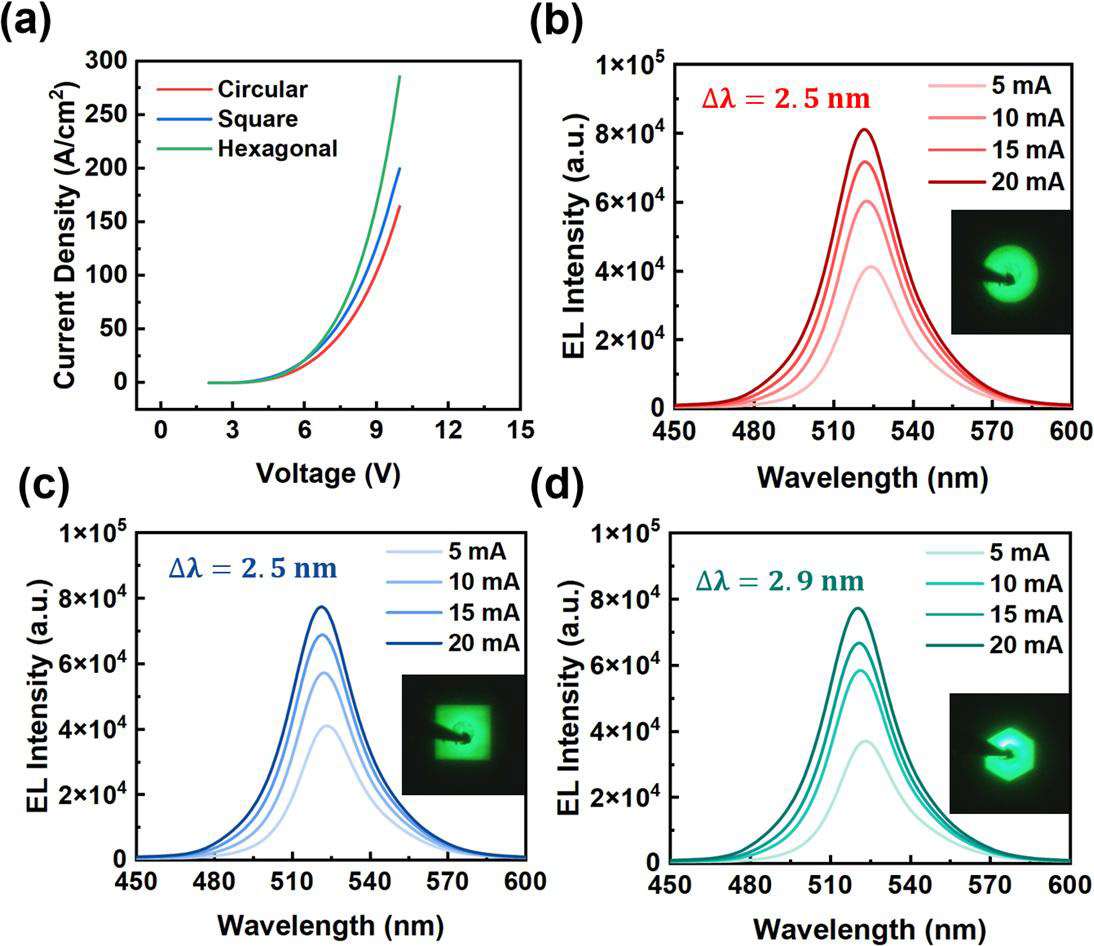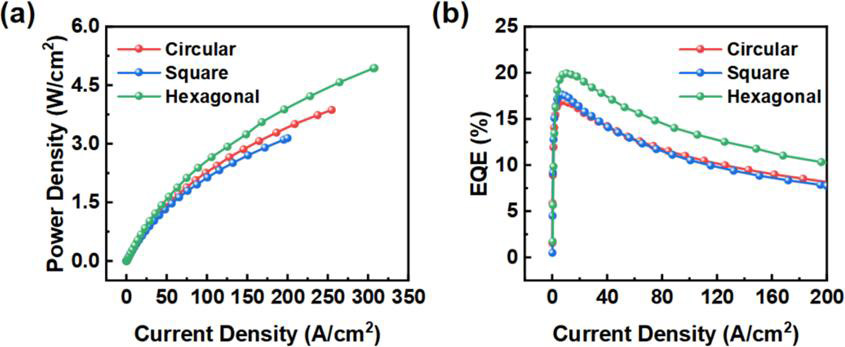News: LEDs
23 October 2025
Benefits of hexagonal mesa for micro-LEDs
Xiamen University in China has reported on the advantages of using hexagonal mesas in indium gallium nitride (InGaN) micro green light-emitting diodes (LEDs) [Zelong Huang et al, Optics Express, v33, p42747, 2025].
The researchers comment: “The hexagonal structure benefits from six uniformly distributed vertices, which minimize the maximum distance from the electrode to the mesa boundary. This design not only provides better current uniformity than the circular mesa but also avoids the current crowding at the vertices observed in the square mesa. Consequently, the hexagonal mesa improves current diffusion efficiency along the edges, reduces localized low-current-density regions, and ultimately enhances overall current uniformity.”
The team sees micro-LEDs as particularly important for full-color displays, augmented/virtual reality (AR/VR), visible light communication, wearable devices, and phototherapy. “Green micro-LEDs are particularly critical for high-fidelity color reproduction due to their emission wavelength within the human eye’s peak sensitivity range,” the researchers explain.
The III-N heterostructure was grown on patterned sapphire substrate by metal-organic chemical vapor deposition (MOCVD). The active light-emitting region consisted of 10 periods of 2nm In0.3Ga0.7N separated by 8nm GaN barriers. Mesa LEDs were fabricated using this material, etched into circular, square and hexagonal patterns, samples A–C, respectively, using laser-direct write photolithography. The mesa etching was by inductively coupled plasma reactive ions and wet buffered oxide etching, and cleaning steps. The perimeter surfaces were passivated with plasma-enhanced chemical vapor deposited silicon dioxide, aimed at mitigating etching-induced damage and enhancing device stability and performance.
The annealed p- and n-metal electrodes consisted of titanium/aluminium/titanium with lift-off carried out in acetone with low-power ultrasonic agitation. The p-electrodes were 50μm-diameter circles placed in the center of the LED. The LEDs were arrayed in a square lattice at 200μm pitch in orthogonal x,y directions.
Table 1: Perimeter/p-electrode area (P/A) for the different mesa shapes with 50μm p-electrode.
Parameter |
Circular | Square | Hexagonal |
| P | 2πx50μm | 4x100μm | 6x50μm |
| P/A | 0.16/μm | 0.20/μm | 0.15/μm |
| Maximum distance to perimeter | 25μm | 45.7μm | 25μm |
| Minimum distance to perimeter | 25μm | 25μm | 18.3μm |
The perimeters of the mesas were such that the hexagonal mesa was least (Table 1). In micro LEDs, the mesa perimeter tends to be where non-radiative recombination occurs, wasting electrical energy. In particular, the LEDs are thought to suffer from increased Shockley–Read–Hall recombination through defects arising from damage due to the (usually plasma) etching process.

Figure 1: (a) Current density–voltage curves of three mesa-geometric micro-LEDs. (b)–(d) Electroluminescence (EL) spectra with insets of luminescence patterns for circular (b), square (c), hexagonal (d) mesas under continuous wave (CW) operation.
The turn-on voltages of the final LEDs were stable about 3.3V (Figure 1). The hexagonal mesa LED achieves higher current density at a given voltage. At 10V bias, the current densities were 164.7A/cm2, 199.9A/cm2 and 285.8A/cm2 for the circular, square and hexagonal mesa LEDs, respectively. The hexagon device had a larger wavelength blue-shift of 2.9nm (Δλ) between 5mA and 20mA current injection.
The researchers comment: “This larger blue-shift in the hexagonal device can be attributed to more efficient carrier injection and uniform distribution in its active region, consistent with its optimized P/A ratio and confirming its superior optoelectronic performance.”

Figure 2: (a) Optical output power density and (b) external quantum efficiency (EQE) of circular, square and hexagonal green micro-LEDs as a function of injected current density.
The optical power density reached 3.86W/cm2, 3.14W/cm2 and 4.94W/cm2 for circular, square and hexagonal micro-LEDs, respectively, at 200A/cm2 injection (Figure 2). The corresponding peak EQE points were at 8.94A/cm2, 7.13A/cm2 and 10.41A/cm2 injection, achieving EQEs of 16.9%, 17.6% and 19.9%, respectively. The EQE droops between the peak and 200A/cm2 were 52.4%, 56.1% and 48.2% for circular, square and hexagonal micro-LEDs, respectively.
InGaN micro green LEDs InGaN Green LEDs MOCVD
https://doi.org/10.1364/OE.575731
The author Mike Cooke is a freelance technology journalist who has worked in the semiconductor and advanced technology sectors since 1997.









